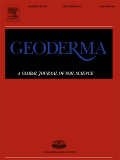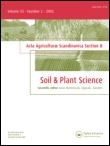
Soil
Scope & Guideline
Empowering Sustainable Practices Through Soil Science
Introduction
Aims and Scopes
- Soil Carbon Dynamics:
Research focusing on the storage, sequestration, and cycling of soil organic carbon, emphasizing the impact of different land uses and management practices. - Soil Properties and Management:
Investigations into various soil properties, including physical, chemical, and biological attributes, and how they influence agricultural productivity and ecosystem health. - Soil Contamination and Remediation:
Studies addressing the presence of pollutants in soils and the effectiveness of various remediation techniques, including phytoremediation and organic amendments. - Soil-Plant Interactions:
Explorations of the relationships between soil characteristics and plant health, including the roles of soil microbiomes and nutrient dynamics. - Technological Advancements in Soil Research:
Innovative approaches and methodologies for soil assessment, including remote sensing, machine learning, and advanced spectroscopic techniques. - Soil Erosion and Conservation:
Research on the processes of soil erosion, its impacts on land degradation, and strategies for conservation and sustainable land management.
Trending and Emerging
- Climate Change Impact on Soil:
Research exploring the effects of climate change on soil properties, carbon cycling, and ecosystem services has gained momentum, highlighting the urgent need to understand soil resilience. - Soil Health and Sustainability:
An increasing number of studies focus on soil health indicators and sustainable practices that enhance soil quality and agricultural productivity. - Soil Microbiome and Ecosystem Function:
Emerging research on the role of soil microbiomes in nutrient cycling, carbon sequestration, and ecosystem services reflects a growing recognition of microbial contributions to soil health. - Integrated Soil Management Practices:
There is a trend towards comprehensive approaches that combine agronomic, ecological, and technological strategies for effective soil management. - Use of Advanced Technologies in Soil Research:
The integration of machine learning, remote sensing, and advanced imaging techniques is on the rise, providing new insights into soil characteristics and dynamics.
Declining or Waning
- Traditional Soil Fertility Studies:
Research centered solely on traditional soil fertility aspects, such as nutrient content analysis, has decreased as the focus shifts towards integrated approaches that consider biological and ecological dimensions. - Historical Soil Studies:
Papers focused on historical analyses of soil use and management practices are less frequent, possibly due to a growing emphasis on contemporary and future-oriented research. - Conventional Soil Mapping Techniques:
The reliance on conventional soil mapping methods has waned, as advances in digital soil mapping and machine learning techniques gain prominence. - Simple Soil Microbial Diversity Studies:
Research exclusively examining microbial diversity without considering functional aspects or interactions within the soil ecosystem has become less common. - Single-Aspect Contamination Studies:
Studies investigating specific contaminants in isolation are declining, with a trend towards more holistic assessments of soil health and multifunctionality.
Similar Journals

Geoderma
Advancing Knowledge in Soil and Ecosystem DynamicsGeoderma is a leading academic journal published by ELSEVIER, focused on the vital field of Soil Science. With an impressive impact factor and ranking as Q1 in its category for 2023, this journal stands as a prominent platform for researchers and professionals seeking to explore advanced scientific studies related to soil and its relationships with the ecosystem. Covering a wide range of topics from soil formation and characterization to land use and management practices, Geoderma is recognized for its rigorous peer-review process and is highly regarded within the global scientific community, as evidenced by its ranking of #12 out of 159 in the Scopus categories of Agricultural and Biological Sciences and Soil Science, placing it in the top 92nd percentile. With its inception dating back to 1967, the journal continually adapts and converges its content to meet the evolving demands of soil research until 2024 and beyond, providing invaluable insights for students, professionals, and researchers alike.

ACTA AGRICULTURAE SCANDINAVICA SECTION B-SOIL AND PLANT SCIENCE
Exploring the Interactions of Soil and Crop for a Greener TomorrowACTA AGRICULTURAE SCANDINAVICA SECTION B-SOIL AND PLANT SCIENCE, published by Taylor & Francis AS, is a distinguished journal dedicated to the fields of Agronomy, Crop Science, and Soil Science. With an impressive impact factor, and categorized in Q2 for both Agronomy and Crop Science and Soil Science as of 2023, this journal is an essential resource for researchers, professionals, and students aiming to advance their understanding of soil-plant interactions and sustainable agricultural practices. Operating since 1992 and continuing through to 2024, ACTA aims to publish high-quality, peer-reviewed research that encourages the applicability of advanced scientific knowledge in real-world agricultural settings. While the journal is not open access, it remains widely accessible through institutional subscriptions, reflecting its commitment to disseminating essential findings and fostering innovation in soil and plant science worldwide. Nestled in the vibrant academic environment of Norway, ACTA AGRICULTURAE SCANDINAVICA serves as a key platform for nurturing groundbreaking research that informs sustainable agricultural policies and practices globally.

CATENA
Elevating Research in Earth-Surface Processes Since 1973CATENA is a distinguished academic journal published by Elsevier, focusing on the critical field of Earth-Surface Processes. With a solid foundation established in 1973, CATENA has continuously evolved, offering a platform for high-impact research and groundbreaking discoveries in geosciences. The journal holds an impressive Scopus rank of #8 out of 179 in its category, placing it in the top 5% of its field, which underscores its importance and influence among researchers and practitioners alike. While CATENA does not operate under an open access model, its commitment to disseminating essential findings is evident in its rigorous peer-review process and inclusion of diverse studies. Located in the Netherlands, CATENA not only serves as an essential resource for professionals and students but also contributes valuable insights that help address global environmental challenges.

SOIL & TILLAGE RESEARCH
Exploring Innovations in Soil ManagementSOIL & TILLAGE RESEARCH is a premier international journal dedicated to advancing the understanding of soil science and tillage practices through high-quality research and insightful reviews. Published by Elsevier and based in the Netherlands, this esteemed journal boasts impressive impact metrics, being ranked in the Q1 category across multiple domains including Agronomy and Crop Science, Earth-Surface Processes, and Soil Science, reflecting its pivotal role in the academic community. With an H-Index that underscores its citation impact and a Scopus ranking placing it in the top percentiles of its field, SOIL & TILLAGE RESEARCH serves as a vital resource for researchers and professionals focusing on sustainable agricultural practices, soil management, and environmental conservation. This journal provides a platform for open dialogue and dissemination of knowledge that shapes future research directions and policy-making in land use and sustainable agriculture.

Soil Systems
Exploring Earth’s Foundations: Unraveling Soil SecretsSoil Systems, published by MDPI, is a premier open access journal dedicated to advancing the understanding of soil science and earth-surface processes. Launched in 2017, this journal has quickly established itself with a strong presence in the academic community, holding a prestigious Q1 ranking in both Earth-Surface Processes and Soil Science as of 2023. With an impressive Scopus rank in the top 20% of its categories, Soil Systems is an essential platform for disseminating groundbreaking research addressing the challenges and complexities of soil management, its ecological significance, and its role in sustainable development. The journal operates under an open access model since 2018, ensuring maximum visibility and accessibility for researchers, professionals, and students alike. Based in Switzerland, at ST ALBAN-ANLAGE 66, CH-4052 BASEL, Soil Systems encourages contributions that promote interdisciplinary collaboration, innovative methodologies, and the application of findings to real-world issues related to soil health and environmental sustainability.

SAINS TANAH
Fostering Sustainable Practices in Soil and Crop ManagementSAINS TANAH is a renowned peer-reviewed journal that focuses on the fields of agronomy, soil science, and environmental studies, published by Universitas Sebelas Maret Surakarta in Indonesia. Established as an Open Access platform since 2001, it aims to disseminate high-quality research that addresses critical issues in soil health, crop management, and pollution, thereby fostering sustainable agricultural practices. With its current impact factor demonstrating a Category Quartile ranking of Q3 and Q4 in major areas such as Agronomy and Crop Science, Atmospheric Science, and Pollution, SAINS TANAH serves as an essential resource for researchers, professionals, and students dedicated to advancing knowledge and solutions in these vital fields. By providing a collaborative environment and upholding rigorous academic standards, the journal not only highlights the significance of Indonesian research contributions but also aims to connect local insights with global agricultural and environmental challenges.

REVISTA BRASILEIRA DE CIENCIA DO SOLO
Connecting Researchers to Transform Soil PracticesREVISTA BRASILEIRA DE CIENCIA DO SOLO, published by the SOC BRASILEIRA DE CIENCIA DO SOLO, serves as a vital open-access platform for disseminating impactful research in the fields of Agronomy and Soil Science. With an ISSN of 0100-0683 and an E-ISSN of 1806-9657, this journal has been fostering academic dialogue since 2003 and has gained recognition as a Q2 journal in both Agronomy and Soil Science as of 2023. Based in Brazil and actively supporting scientists and practitioners globally, it is uniquely positioned to address the challenges and innovations in soil management and cultivation practices. The journal's Scopus rankings reflect its commitment to quality, standing at #164/406 in Agronomy and Crop Science and #74/159 in Soil Science, placing it in the top quartile of its category. Researchers, professionals, and students are encouraged to contribute their findings and insights, making it a significant resource for anyone interested in advancing the science of soil and crop stewardship.

SOIL SCIENCE AND PLANT NUTRITION
Nurturing research for thriving ecosystems.SOIL SCIENCE AND PLANT NUTRITION, published by Taylor & Francis Ltd, stands as a prominent journal in the fields of plant science and soil science, with its impact reflected in its Q2 ranking across both categories in 2023. Established in 1955, this journal provides a vital platform for researchers, professionals, and students dedicated to understanding the complex interactions between soil and plant nutrition, with an emphasis on advancing sustainable agricultural practices. With an impressive Scopus ranking, placing it in the 75th percentile for Plant Science and the 71st for Soil Science, it attracts high-quality, peer-reviewed articles that contribute significantly to the body of knowledge in these disciplines. While the journal does not currently offer Open Access options, its comprehensive scope encompasses studies from fundamental research to applied science, making it an essential resource for anyone engaged in soil management, agronomy, or related fields.

Frontiers in Soil Science
Transforming soil science through collaboration.Frontiers in Soil Science, published by FRONTIERS MEDIA SA in Switzerland, is an esteemed open-access journal dedicated to advancing our understanding of soil systems and their vital role in ecosystem functioning and sustainable agricultural practices. Since its inception in 2021, this journal has quickly established itself within the scientific community, boasting a 2023 Scopus Q2 ranking in Soil Science and a notable percentile of 41 among its peers. Researchers and practitioners in the field will find a wide array of original research, reviews, and contributions that address key topics such as soil health, carbon sequestration, and nutrient cycling. With a commitment to fostering collaboration and dissemination of knowledge, Frontiers in Soil Science serves as a vital resource for professionals, researchers, and students who aspire to innovate and lead in soil science research.

Applied and Environmental Soil Science
Advancing sustainable solutions for soil and environmental health.Applied and Environmental Soil Science, an esteemed journal published by HINDAWI LTD, focuses on disseminating high-quality research in the fields of soil science and environmental applications. With an ISSN of 1687-7667 and an E-ISSN of 1687-7675, this open-access journal has been a vital resource for the academic community since its inception in 2009. As of 2023, it holds a commendable position in the Q2 category for both Earth-Surface Processes and Soil Science, highlighting its impact in these crucial disciplines. The journal’s rankings further affirm its significance within the field, being placed 61st in Earth and Planetary Sciences and 58th in Agricultural and Biological Sciences. Researchers and practitioners alike benefit from the collaborative platform it offers for sharing innovative studies essential for sustainable soil management and environmental integrity. With a focus on advancing knowledge and fostering interdisciplinary dialogue, Applied and Environmental Soil Science stands as a crucial pillar for scholars and professionals dedicated to addressing the pressing challenges of soil and environmental health.